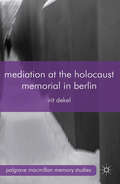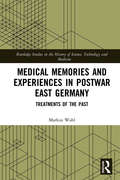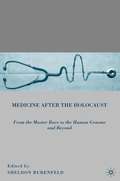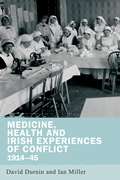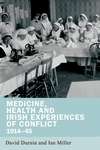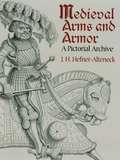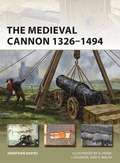- Table View
- List View
Mediating in Cyprus: The Cypriot Communities and the United Nations
by Oliver P. RichmondThe UN peacemaking operation in Cyprus has been one of the longest of its kind, but has resulted in discarded proposals, non-papers or reports. This study investigates the Cypriot parties' views of peacemaking, to shed light on the problem, and on the theoretical debates surrounding mediation.
Mediation at the Holocaust Memorial in Berlin (Palgrave Macmillan Memory Studies)
by I. DekelAnalyzing action at the Holocaust memorial in Berlin, this first ethnography of the site offers a fresh approach to studying the memorial and memory work as potential civic engagement of visitors with themselves and others rather than with history itself.
The Medic: Life and Death in the Last Days of WWII
by Leo LitwakLeo Litwak was a university student when he joined the Army to fight in World War II, "a na've, callow eighteen-year-old son prepared to join other soldier boys being hauled off to war." In 1944 he found himself in Belgium, in the middle of the waning European war, a medic trained to save lives but often powerless to do much more than watch life slip away. It was hard fighting that took Litwak and his rifle company into the heart of Germany at the close of the war. But Litwak learned there was more to war than fighting, more to understand than maps and ammunition. In the final months of the war, he watched the men in his company tenderly serve food at a Passover seder for a dozen brutalized Jewish women newly liberated from slavery. He watched those same men torture and execute defenseless German soldiers. He fell in love at the Moulin Rouge in a scene straight out of a Toulouse-Lautrec painting. The men in his company were dreamers, thieves, friends, killers, revolutionaries, and heroes. They were the men of their time: sometimes brave, sometimes compassionate, sometimes cruel, sometimes loving, usually scared. They were held together by loyalty, only to be scattered by the war's end. The Medic is the gritty, wise, bighearted, and unflinching account of one man's quest to find sense in war and its aftermath.
Medical Memories and Experiences in Postwar East Germany: Treatments of the Past (Routledge Studies in the History of Science, Technology and Medicine)
by Markus WahlThis book draws on the example of the major cities of Leipzig and Dresden to illustrate continuity and change in public health in the German Democratic Republic. Based on archival work, it will demonstrate how members of the medical profession successfully manipulated their pre-1945 past in order to continue practising, leading to persistence in the social conception of medicine and disease after Communism took hold. This was particularly evident in attitudes towards and treatment of sexually transmitted diseases and the pathology of deviant behaviour among young people.
Medical Memories and Experiences in Postwar East Germany: Treatments of the Past (Routledge Studies in the History of Science, Technology and Medicine)
by Markus WahlThis book draws on the example of the major cities of Leipzig and Dresden to illustrate continuity and change in public health in the German Democratic Republic. Based on archival work, it will demonstrate how members of the medical profession successfully manipulated their pre-1945 past in order to continue practising, leading to persistence in the social conception of medicine and disease after Communism took hold. This was particularly evident in attitudes towards and treatment of sexually transmitted diseases and the pathology of deviant behaviour among young people.
Medical Services in the First World War (Shire Library #792)
by Susan CohenThe number of wounded in the First World War was unprecedented, and inadequate military planning presented the medical and voluntary community with huge and daunting challenges. Yet in the face of tremendous adversity both tackled their work with resourcefulness, courage and great humanity. This book is the illustrated story of those who risked their lives collecting casualties from the front line, of the various transport and treatment facilities at their disposal and of the eclectic mix of buildings in which the wounded were cared for at home, including many famous country houses. The vital part played by nurses, both in terms of essential medical duties and in boosting morale among the patients, is also examined, rounding off this perfect introduction to medical care in the First World War. Susan Cohen is an historian with a special interest in twentieth century British social history and refugee studies. She has lectured widely on a variety of subjects and published numerous books, including The District Nurse, The Women's Institute, The Scouts and The Salvation Army for Shire.
Medicine after the Holocaust: From the Master Race to the Human Genome and Beyond
by S. RubenfeldRubenfeld and the contributors to this collection posit that German physicians betrayed the Hippocratic Oath when they chose knowledge over wisdom, the state over the individual, a führer over God, and personal gain over professional ethics.
Medicine and Conflict: The Spanish Civil War and its Traumatic Legacy (Routledge/Canada Blanch Studies on Contemporary Spain)
by Sebastian BrowneThis book focuses on an important but neglected aspect of the Spanish Civil War, the evolution of medical and surgical care of the wounded during the conflict. Importantly, the focus is from a mainly Spanish perspective – as the Spanish are given a voice in their own story, which has not always been the case. Central to the book is General Franco’s treatment of Muslim combatants, the anarchist contribution to health, and the medicalisation of propaganda – themes that come together in a medico-cultural study of the Spanish Civil War. Suffusing the narrative and the analysis is the traumatic legacy of conflict, an untreated wound that a new generation of Spaniards are struggling to heal.
Medicine and Conflict: The Spanish Civil War and its Traumatic Legacy (Routledge/Canada Blanch Studies on Contemporary Spain)
by Sebastian BrowneThis book focuses on an important but neglected aspect of the Spanish Civil War, the evolution of medical and surgical care of the wounded during the conflict. Importantly, the focus is from a mainly Spanish perspective – as the Spanish are given a voice in their own story, which has not always been the case. Central to the book is General Franco’s treatment of Muslim combatants, the anarchist contribution to health, and the medicalisation of propaganda – themes that come together in a medico-cultural study of the Spanish Civil War. Suffusing the narrative and the analysis is the traumatic legacy of conflict, an untreated wound that a new generation of Spaniards are struggling to heal.
Medicine, health and Irish experiences of conflict, 1914–45
by Ian Miller David DurninA wide ranging volume on medical history, that examines critical areas of health concerns in Ireland through the World Wars.
Medicine, health and Irish experiences of conflict, 1914–45 (PDF)
by Ian Miller David DurninA wide ranging volume on medical history, that examines critical areas of health concerns in Ireland through the World Wars.
Medicine in First World War Europe: Soldiers, Medics, Pacifists
by Fiona ReidThe casualty rates of the First World War were unprecedented: approximately 10 million combatants were wounded from Britain, France and Germany alone. In consequence, military-medical services expanded and the war ensured that medical professionals became firmly embedded within the armed services. In a situation of total war civilians on the home front came into more contact than before with medical professionals, and even pacifists played a significant medical role. Medicine in First World War Europe re-visits the casualty clearing stations and the hospitals of the First World War, and tells the stories of those who were most directly involved: doctors, nurses, wounded men and their families. Fiona Reid explains how military medicine interacts with the concerns, the cultures and the behaviours of the civilian world, treating the history of wartime military medicine as an integral part of the wider social and cultural history of the First World War.
Medicine in First World War Europe: Soldiers, Medics, Pacifists
by Fiona ReidThe casualty rates of the First World War were unprecedented: approximately 10 million combatants were wounded from Britain, France and Germany alone. In consequence, military-medical services expanded and the war ensured that medical professionals became firmly embedded within the armed services. In a situation of total war civilians on the home front came into more contact than before with medical professionals, and even pacifists played a significant medical role. Medicine in First World War Europe re-visits the casualty clearing stations and the hospitals of the First World War, and tells the stories of those who were most directly involved: doctors, nurses, wounded men and their families. Fiona Reid explains how military medicine interacts with the concerns, the cultures and the behaviours of the civilian world, treating the history of wartime military medicine as an integral part of the wider social and cultural history of the First World War.
Medicines for the Union Army: The United States Army Laboratories During the Civil War
by Dennis B Worthen Greg HigbyIt wasn't only combat that killed during the Civil War!Among white Federalist troops alone, there were 1,213,685 cases of malaria, 139,638 cases of typhoid fever, 67,762 cases of measles, 61,202 cases of pneumonia, 73,382 cases of syphilis, and 109,202 cases of gonorrhea between May 1, 1861 and June 30, 1866. (Statistics for Negro troops covered less than three years of the Civil War period.)Preventative medicine at the time had little more to offer than quinine and a few disinfectants. There was no real understanding of the germ theory of disease. But Medicines for the Union Army: The United States Army Laboratories During the Civil War shows that in the evolution of the army's Medical Department from incompetence to general efficiency during this time, and in the vastly improved organization and supply system designed by William A. Hammond, Jonathan Letterman, the medical purveyors, and others working under the Surgeon General, there was evidence of a great achievement.In Medicines for the Union Army you will come to understand the medical purveying system of the time and its problems, and you will witness the birth, growth, and remarkable achievements of the Federal government's pharmaceutical laboratories at Astoria, New York, and Philadelphia, Pennsylvania.Medicines for the Union Army will inform and enlighten you about the these laboratories, including: the funding and transportation obstacles faced at the Astoria lab the processes by which raw materials became drugs ready for distribution drug testing and inspection methods the bottling of “medicinal whiskey” and wine at the labs the people whose work laid the foundation for modern drug production and distribution methods the contents of the medical supply cases (panniers) and wagons in use at the time . . . and much more!Medicines for the Union Army: The United States Army Laboratories During the Civil War brings to light the groundbreaking achievements of unsung American heroes working to preserve life while the country was in bloody turmoil. No Civil War historian should be without this volume!
Medicines for the Union Army: The United States Army Laboratories During the Civil War
by Dennis B Worthen Greg HigbyIt wasn't only combat that killed during the Civil War!Among white Federalist troops alone, there were 1,213,685 cases of malaria, 139,638 cases of typhoid fever, 67,762 cases of measles, 61,202 cases of pneumonia, 73,382 cases of syphilis, and 109,202 cases of gonorrhea between May 1, 1861 and June 30, 1866. (Statistics for Negro troops covered less than three years of the Civil War period.)Preventative medicine at the time had little more to offer than quinine and a few disinfectants. There was no real understanding of the germ theory of disease. But Medicines for the Union Army: The United States Army Laboratories During the Civil War shows that in the evolution of the army's Medical Department from incompetence to general efficiency during this time, and in the vastly improved organization and supply system designed by William A. Hammond, Jonathan Letterman, the medical purveyors, and others working under the Surgeon General, there was evidence of a great achievement.In Medicines for the Union Army you will come to understand the medical purveying system of the time and its problems, and you will witness the birth, growth, and remarkable achievements of the Federal government's pharmaceutical laboratories at Astoria, New York, and Philadelphia, Pennsylvania.Medicines for the Union Army will inform and enlighten you about the these laboratories, including: the funding and transportation obstacles faced at the Astoria lab the processes by which raw materials became drugs ready for distribution drug testing and inspection methods the bottling of “medicinal whiskey” and wine at the labs the people whose work laid the foundation for modern drug production and distribution methods the contents of the medical supply cases (panniers) and wagons in use at the time . . . and much more!Medicines for the Union Army: The United States Army Laboratories During the Civil War brings to light the groundbreaking achievements of unsung American heroes working to preserve life while the country was in bloody turmoil. No Civil War historian should be without this volume!
Medieval Arms and Armor: A Pictorial Archive
by J. H. Hefner-AlteneckA renowned 19th-century cultural historian and specialist on the Middle Ages, J. H. Hefner-Alteneck spent much of his life observing the influence of art on many aspects of human life, including weaponry. His illustrations for this handsome archive — drawn with incredible exactitude — depict a wide array of medieval weapons and armor dating from the early ninth century to the mid-1700s.Adapted primarily from decorative ornamentation on burial monuments and manuscripts, hundreds of finely executed images depict authentic shields, swords, crossbows, helmets, and highly ornate suits of body armor for knights and their steeds. Newly translated descriptive notes, extracted from the original German text, identify the subjects. First published more than 100 years ago, this meticulously rendered study remains an invaluable source of permission-free illustrations for artists and designers and an indispensable reference for scholars, collectors, and hobbyists.
The Medieval Cannon 1326–1494: The Artillery That Transformed European Warfare (New Vanguard)
by Jonathan DaviesThe first illustration of a cannon in Europe can be dated quite precisely to 1326. This book explores the development of gunpowder, the earliest appearance of cast-bronze cannon in Western Europe, followed by the design and development of the wrought-iron cannon. The wrought-iron hoop-and-stave method of barrel construction was a system that came to dominate medieval artillery design both large and small until the end of the 15th century, and saw the cannon used not only as a prestige weapon, but start to be used as a practical and terrifying weapon on the medieval battlefield. In 1453, the Ottomans' conquest of Constantinople, with their extensive artillery, marked the triumph of medieval firepower. The book will focus on the technology and tactics of early European artillery on both sea and land, and assess its impact on medieval warfare.
The Medieval Cannon 1326–1494: The Artillery That Transformed European Warfare (New Vanguard #273)
by Jonathan DaviesThe first illustration of a cannon in Europe can be dated quite precisely to 1326. This book explores the development of gunpowder, the earliest appearance of cast-bronze cannon in Western Europe, followed by the design and development of the wrought-iron cannon. The wrought-iron hoop-and-stave method of barrel construction was a system that came to dominate medieval artillery design both large and small until the end of the 15th century, and saw the cannon used not only as a prestige weapon, but start to be used as a practical and terrifying weapon on the medieval battlefield. In 1453, the Ottomans' conquest of Constantinople, with their extensive artillery, marked the triumph of medieval firepower. The book will focus on the technology and tactics of early European artillery on both sea and land, and assess its impact on medieval warfare.
Medieval Chinese Warfare 300-900 (Warfare and History)
by David GraffShortly after 300 AD, barbarian invaders from Inner Asia toppled China's Western Jin dynasty, leaving the country divided and at war for several centuries. Despite this, the empire gradually formed a unified imperial order. Medieval Chinese Warfare, 300-900 explores the military strategies, institutions and wars that reconstructed the Chinese empire that has survived into modern times.Drawing on classical Chinese sources and the best modern scholarship from China and Japan, David A. Graff connects military affairs with political and social developments to show how China's history was shaped by war.
Medieval Chinese Warfare 300-900 (Warfare and History)
by David GraffShortly after 300 AD, barbarian invaders from Inner Asia toppled China's Western Jin dynasty, leaving the country divided and at war for several centuries. Despite this, the empire gradually formed a unified imperial order. Medieval Chinese Warfare, 300-900 explores the military strategies, institutions and wars that reconstructed the Chinese empire that has survived into modern times.Drawing on classical Chinese sources and the best modern scholarship from China and Japan, David A. Graff connects military affairs with political and social developments to show how China's history was shaped by war.
Medieval European Armies (Men-at-Arms)
by Terence Wise Gerry EmbletonAlmost continual warfare raged in Europe during the period 1300-1500. These wars were the furnaces in which many of the modern European nations were forged. Parallel with this emergence of the nations came the development of national armies to protect the newly-won borders and independence, yet throughout this period the old feudal method of raising an army persisted. This fascinating study by Terence Wise explores the organisation, weapons and equipment of the armies who fought across medieval Europe, from the Hundred Years War to the fight against the Moors in Spain and the French invasion of Italy.
Medieval European Armies (Men-at-Arms #50)
by Terence Wise Gerry EmbletonAlmost continual warfare raged in Europe during the period 1300-1500. These wars were the furnaces in which many of the modern European nations were forged. Parallel with this emergence of the nations came the development of national armies to protect the newly-won borders and independence, yet throughout this period the old feudal method of raising an army persisted. This fascinating study by Terence Wise explores the organisation, weapons and equipment of the armies who fought across medieval Europe, from the Hundred Years War to the fight against the Moors in Spain and the French invasion of Italy.
Medieval Handgonnes: The first black powder infantry weapons (Weapon)
by Gerry Embleton Sean McLachlan Sam EmbletonIn the early 14th century, a new weapon entered the arsenals of European armies. This first generation of black powder weapons put fear into the heart of the enemy and in 1453 Ottoman cannon succeeded in pummelling the once-impregnable walls of Constantinople. But cannons, which are both slow and cumbersome, were difficult to use and often proved inaccurate. The first handgonnes were the answer. Easily dismissed by later historians as nothing more than crude tubes that shot wildly inaccurate lead balls, more recent research has revealed the true accuracy of the medieval handgonne together with its penetrative power. This volume, complete with detailed illustrations and colour photographs of reconstructed handgonnes, reveals the true history of what could easily have been the most revolutionary weapon in history.This book will be a must for medieval enthusiasts and re-enactors.
Medieval Handgonnes: The first black powder infantry weapons (Weapon #3)
by Gerry Embleton Sean McLachlan Sam EmbletonIn the early 14th century, a new weapon entered the arsenals of European armies. This first generation of black powder weapons put fear into the heart of the enemy and in 1453 Ottoman cannon succeeded in pummelling the once-impregnable walls of Constantinople. But cannons, which are both slow and cumbersome, were difficult to use and often proved inaccurate. The first handgonnes were the answer. Easily dismissed by later historians as nothing more than crude tubes that shot wildly inaccurate lead balls, more recent research has revealed the true accuracy of the medieval handgonne together with its penetrative power. This volume, complete with detailed illustrations and colour photographs of reconstructed handgonnes, reveals the true history of what could easily have been the most revolutionary weapon in history.This book will be a must for medieval enthusiasts and re-enactors.
Medieval Indian Armies: Hindu, Buddhist and Jain (Men-at-Arms)
by David NicolleThis fully illustrated study explores the armies of the Hindu, Buddhist and Jain states within what are now India, Pakistan, Bangladesh, Sri Lanka and Nepal during the period AD 500–1500, as well as Afghanistan until the early 13th century AD.Following the emergence of a distinct 'medieval Indian' civilization in the Late Classical and Early Medieval periods, there was a prolonged struggle between this civilization and that of the eastern Islamic world, concluding with the rise of the Mughal Empire at the start of the 16th century. In this fully illustrated study, David Nicolle investigates the traditions and enduring conservatism of non-Islamic medieval Indian warfare, notably evident in recruitment patterns and the significance of archery and cavalry. The role and impact of war-elephants, both positive and negative, are also considered, as well as the influence of climate and weather (notably the seasonal monsoon) on warfare in this region. As well as assessing arms and armour – contrasting the advanced technology and high status of Indian weapons (especially swords) with the remarkable lack of metallic armour in the region during this period – the author also explores siege warfare and riverine and naval warfare in South Asia. This book assesses the contributing factors identified by those who have sought to explain why the huge wealth and substantial populations of the traditional non-Islamic Indian states did not prevent their persistent failure in the face of Islamic invasion and conquest.

